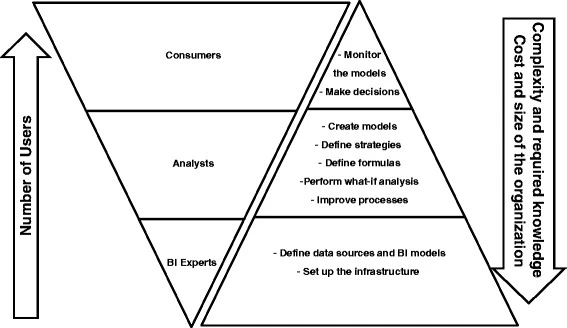Literature review
Roles and responsibilities in an organization
Although the iterative and incremental nature of the framework allows organizations at any size/maturity to start using it, depending on the size of the organization and level of investment, not all aspects of the framework may be readily achievable. The complexity of some aspects of the framework requires specialized skills that not all users in an organization have, and the intention of the framework is also not to expose everyone to the same level of detail and complexity.
Figure 16 illustrates the required roles and responsibilities in an organization to use the framework. In a large organization, most of the users, primarily managers and business users, will only deal with the least complex aspects of the methodology (for consumers) and mainly use a subset of goals and KPIs to monitor their targets. A smaller number of analysts and BI experts will be involved in the more complicated aspects of the methodology. Initially, large organizations with access to such expertise will likely be the key adopters. In larger organizations, people with different functional roles in the organization may take one of these defined roles in the framework. For instance, both executives and line-of-business users can take the consumer role in the framework. In smaller organizations, one may take more than one of defined roles in the framework. For instance, the owner of a small retail store may become both the consumer and the analyst. Wixom and Watson have shown that many large and mature organizations can already benefit from sophisticated BI technologies, so incorporating our methodology in such context should not represent a major challenge. We believe, however, that our plan for using more consumer-oriented BI tools will help us to reduce the skill and cost barriers thus enabling smaller organizations, and especially middle-level managers, to fully utilize all aspects of the methodology.
Figure 16
Roles and responsibilities involved in the methodology.